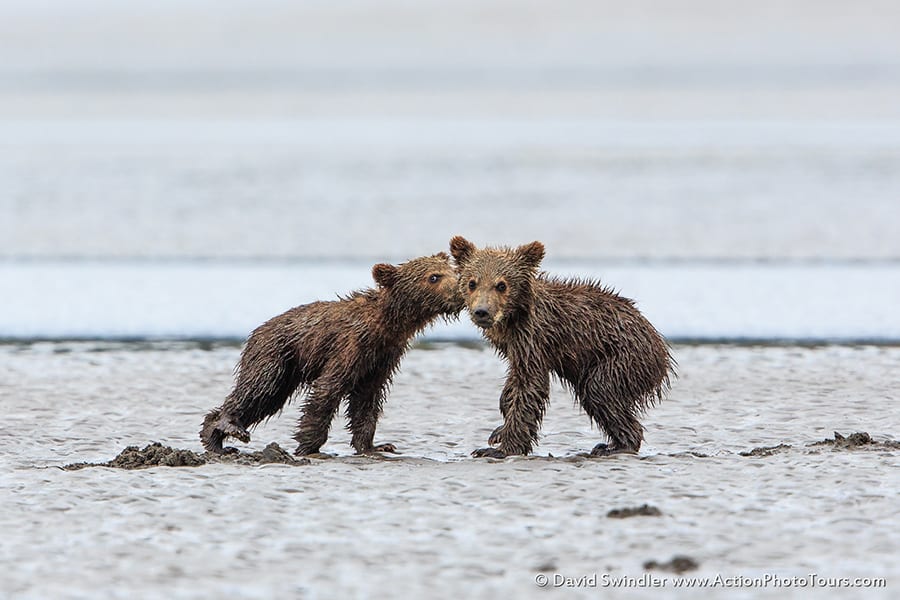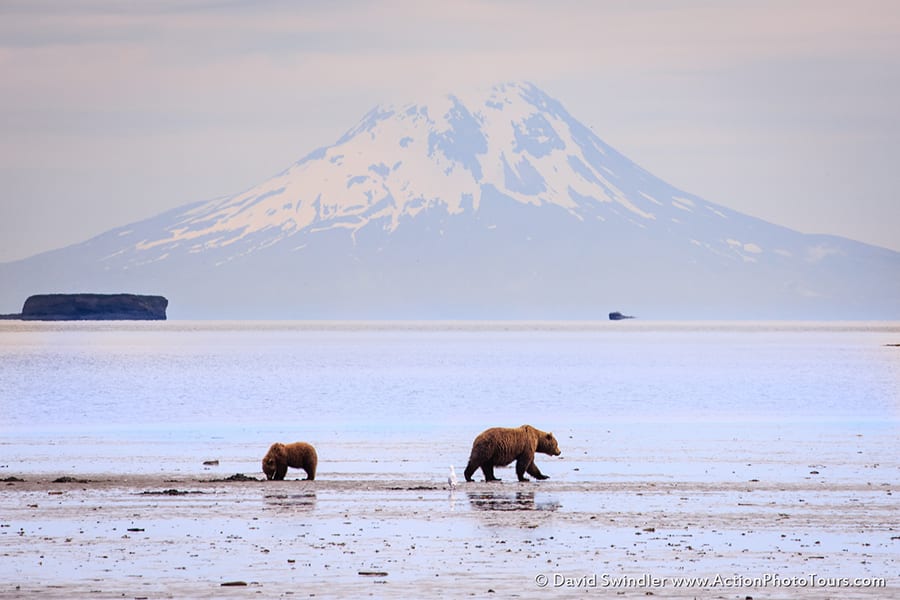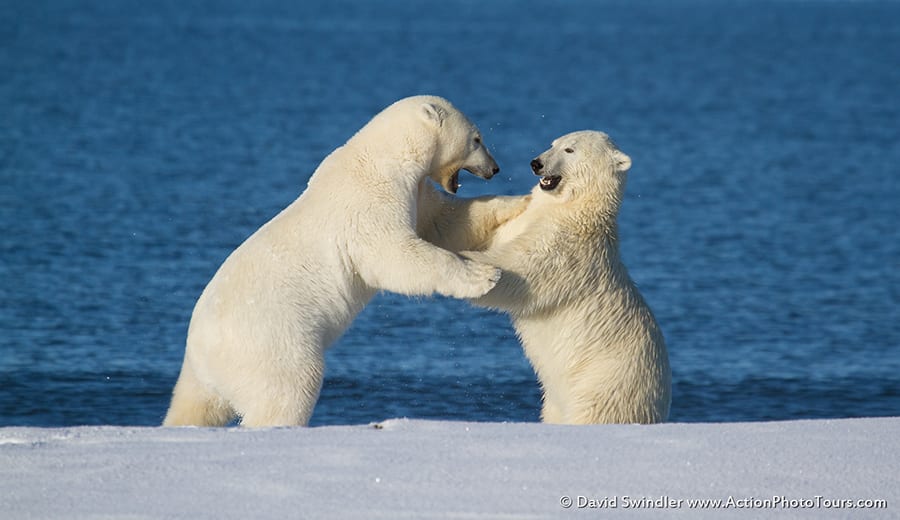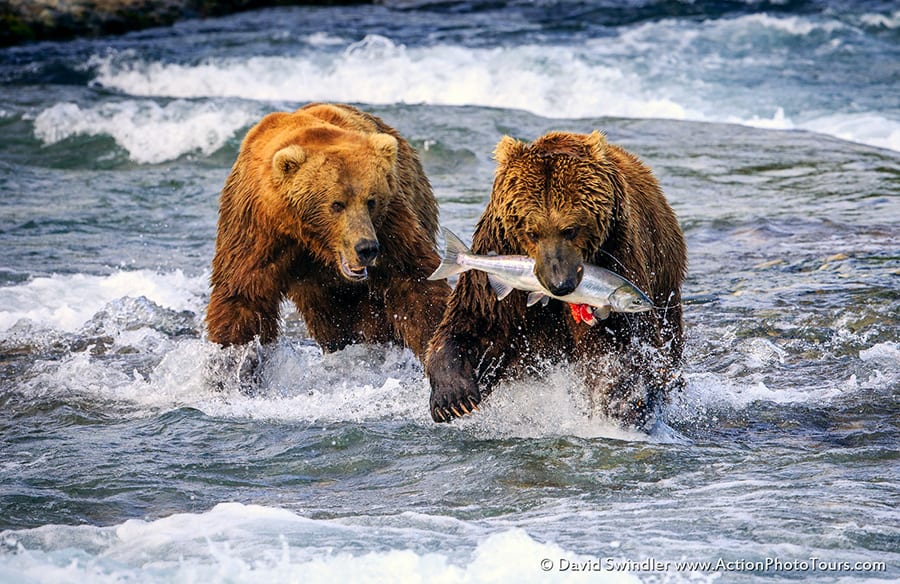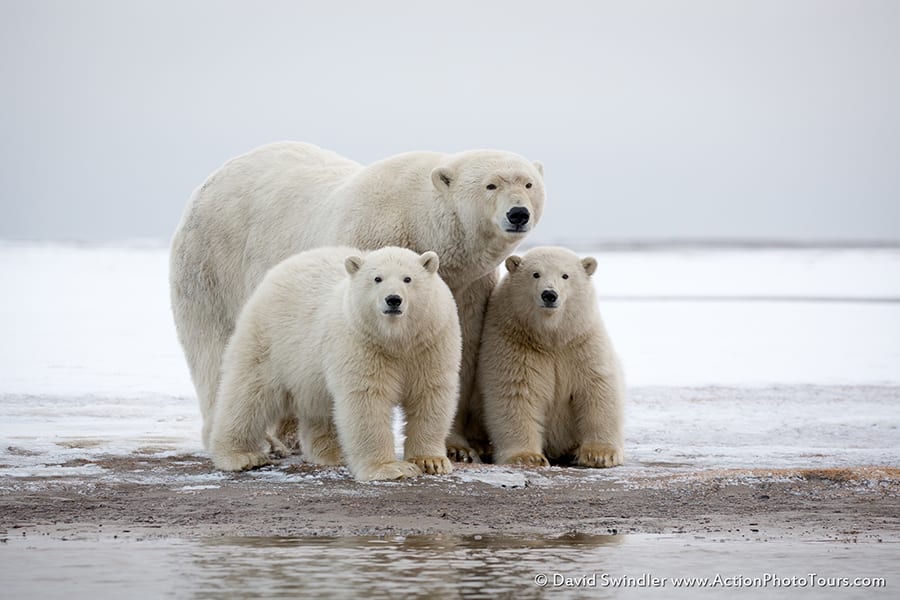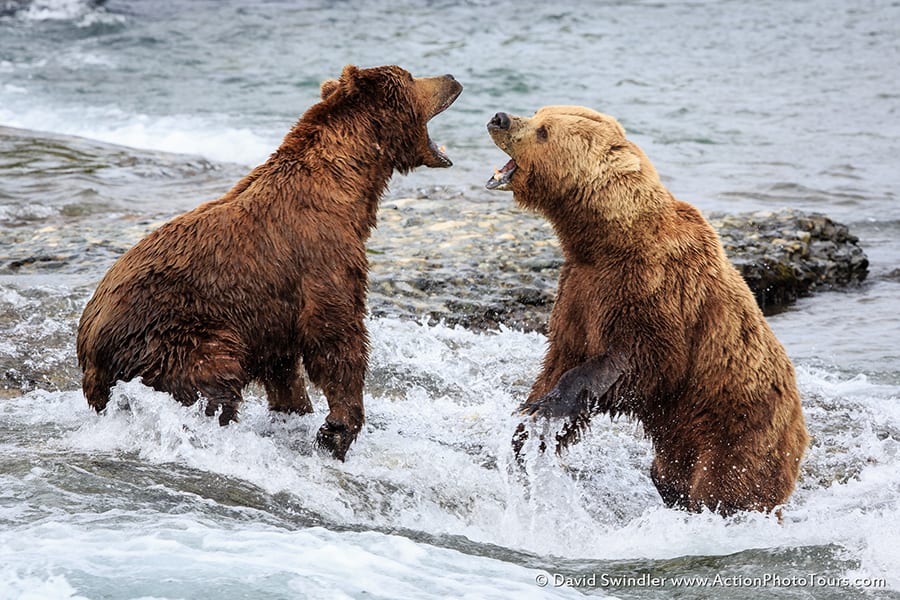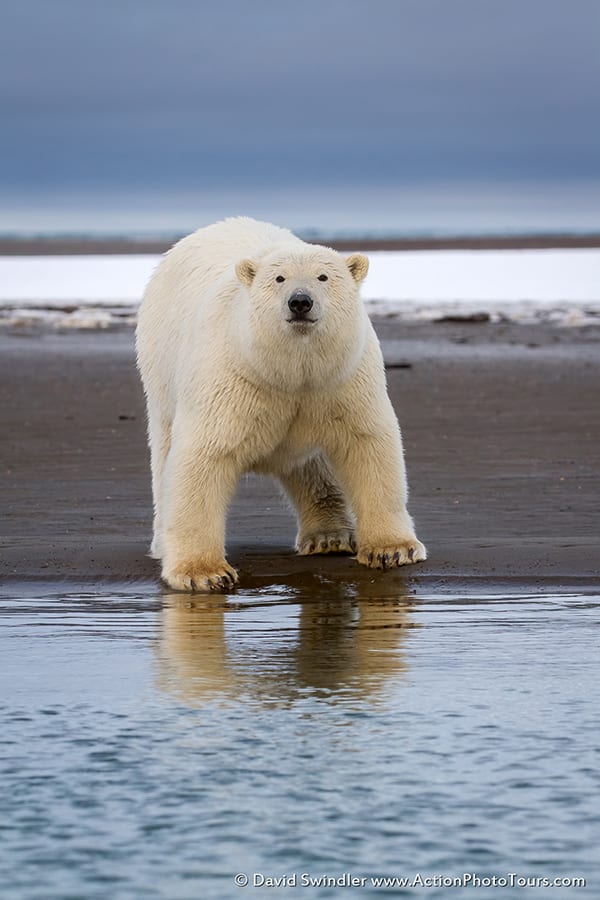Photographing Bears

Out of all wildlife, I enjoy photographing bears the most. They are majestic and powerful animals that demand respect. The patient observer can be rewarded with a glimpse into their complex social network. They can exhibit so many human-like antics, attitudes, and behaviors. It’s fascinating to see them playing with each other, fighting, catching food, attracting a mate, and showing their dominance. The little bear cubs are especially entertaining with their youthful exuberance and curiosity! Photographing bears is time well spent and you’ll come away with many great images and memories.
Where is a good place to photograph bears? It’s easy – Alaska! Although I’ve seen bears in many places, nothing compares to what Alaska offers. You have black and brown bears along the coast, grizzly bears in the interior, and polar bears on the North Slope. The bears in protected areas like Katmai, Lake Clark, Denali, and ANWR are often quite tolerant of human presence and close range viewing is possible. Alaska also has dramatic scenery to accompany the bears. Polar bears are some of my favorites and I offer guided photo trips each fall to the remote Inupiat Village of Kaktovik. I really like Kaktovik since we view the bears from the safety of a boat. While parked near the shore, they will often walk or swim right by us. In 2015, we had over 35 polar bears in the area – many with young cubs.
When is the best time to see the bears? If you go in June, you’ll see spring cubs, wildflowers, and mating behaviors. In July, the salmon start running and you’ll get more fishing action. Depending on the area, salmon runs can persist well into August. In Sept, grizzly bears in the interior are busy foraging and eating berries in preparation for hibernation. During the first week of Sept, you’ll have brilliant fall foliage in Denali. Polar bears are best at the end of Sept and early Oct as they congregate on the northern coast waiting for the sea ice to form. Once the ocean freezes, they spread out over the pack ice to hunt for seals.
Tip #1: Use Two Camera Bodies.
Being able to shoot at a variety of focal lengths is key to getting great shots. I like to keep a long lens on one body (500mm with or without a 1.4x) and a zoom telephoto on the other (100-400mm). When the action is going, you won’t have time to be changing out lenses. Sometimes the bears will come really close to you and you’ll almost wish you had a wide-angle lens. Other times they keep their distance and you’ll be glad you have the long lens. Another thing I tell my workshop attendees is to zoom out a little and show the bears in their surrounding landscape. While intimate close-ups are nice, I often end up preferring the more zoomed out shots at the end of the trip. Plus, it proves you didn’t take your photos at the zoo!
Tip #2: Since bears are often on the move, use Continuous Focus (Nikon) or Servo Focus (Canon).
This allows the camera to continuously adjust focus as the subject moves. I like to set my starting auto-focus point and then allow the camera to track the subject as it moves. If the camera is having difficulty tracking the subject, then I resort to using zone AF and ensure the subject stays centered in that zone. For very accurate AF on more stationary subjects, I will use pin-point AF mode. Being able to quickly change your auto-focus modes and points is very important! Another recommendation is that you learn how to isolate metering and auto-focus.
The default behavior is for the camera to meter and auto-focus when the shutter button is pressed halfway. For wildlife, it’s better to meter the scene with the shutter button and use your back button for AF. There are many tutorials online that will show you how to do this for your particular camera. Back-button focus will allow you focus and recompose while using Continuous or Servo Focus. It also improves your burst rate and makes it so you don’t have to constantly change your AF points.
Tip #3: Depth of Field is important for bears.
Under normal lighting conditions, I recommend using f7.1 – f8 to ensure all of the bear is in sharp focus. This is particularly important for groups of bears. Occasionally I’ll move to f9-f10 for more landscape style zoomed out shots. For creative or dreamy shots, I’ll use f4-f5.6 to blur out portions of the image. It’s often fun to shoot a group of bears with one sharp and the others blurry. When using shallow DOF, it’s helpful to use pin-point AF mode to really get the eyes tack sharp. When light starts getting low, large apertures are needed to avoid excessively high ISO. The high ISO limit will depend on your camera and what level of noise you are comfortable with. Remember, you lose DOF with higher magnification and closer distance to the subject.
Tip #4: Watch your histograms regularly.
When shooting black/brown bears, it’s very important that the fur not be underexposed. Keep the fur tones well away from the left side of the histogram! For polar bears, you have the opposite problem. You need to ensure the white fur and snow do not clip off the right side of the histogram. Turning on the Highlight Clipping Alert in your camera menu will help you see overexposed areas. Note that the histogram is based on JPG rendering, not on full RAW headroom. Thus, you will have more latitude in post-processing than what the camera will imply. Finally, you’ll want to expose to the right as much as you can without clipping. This will improve the signal to noise ratio and provide more post-processing latitude.
Tip #5: Use Av and Manual Shooting Modes.
Av is useful when the lighting conditions are dynamic, such as a partly cloudy day. You set your desired f-stop and then the camera meters the scene to normalize the histogram. You may have to apply exposure compensation depending on the scene (backlight: -1eV, polar bears in snow: +1eV, etc). The danger with Av mode is that you can miss proper exposure on your subject if the background tonality changes. For example, when a polar bear goes from deep blue water to bright white snow, the bear may be under-exposed in the snow with Av Mode. To overcome this deficiency, I use Manual Mode. I will dial-in the proper exposure for the bear and then I don’t have to worry about background tonality. However, you must regularly check your histogram in manual mode as the light can vary throughout the day.
Tip #6: Mind your shutter speeds.
Bears can move surprisingly quick, and slow shutter speeds simply don’t work well for action shots. I recommend a minimum shutter speed of 1/500sec for general use and anywhere from 1/800s to 1/1250s for fast action. This is especially true if snowflakes or water droplets are being flung into the air. When light starts to get low, I will go below 1/500s down somewhere near the IS/VR capability of the lens. But when I do this, I know I will end up with a lot less keepers due to motion blur. Also, don’t bother doing slow shutter speed panning with bears. They usually don’t run fast enough for that to work well.
Tip #7: Get down low!
This tip will make your bear photographs much more dynamic and show their true stature. When photographing bears fishing for salmon, I like to sit down on the ground so it looks like the bear is running straight towards me. On our polar bear trip, we’re on a small boat where we can get down near the water level to photograph the bears. This makes such a huge difference and it’s why I like going to Kaktovik for Polar Bears. You just can’t get that same perspective from the top of a tall polar bear vehicle in Churchill or a large cruise ship in Svalbard.
Tip #8: Be patient and wait for the bears to come to you.
It’s very important that you don’t approach bears. If you do, the bears will either move away or see you as a threat and attack. Many of the best photo opportunities came after we staked out a probable spot for bears and then waited for them to show up. Bears are most active during the morning and evening. If you go during the middle of the day, they are more likely to be sleeping or hunkering down (especially if it’s warm out). Finally, avoid butt shots if possible. Just be patient and wait for the animal to get comfortable enough with you to turn around.
I hope these tips will get you excited to go out and photograph some bears! There’s so much more I could share, but this is meant as just an introductory article. If you want to learn more, feel free to drop me an email. I’d love to see you on one of our upcoming polar bear outings. Happy shooting!

